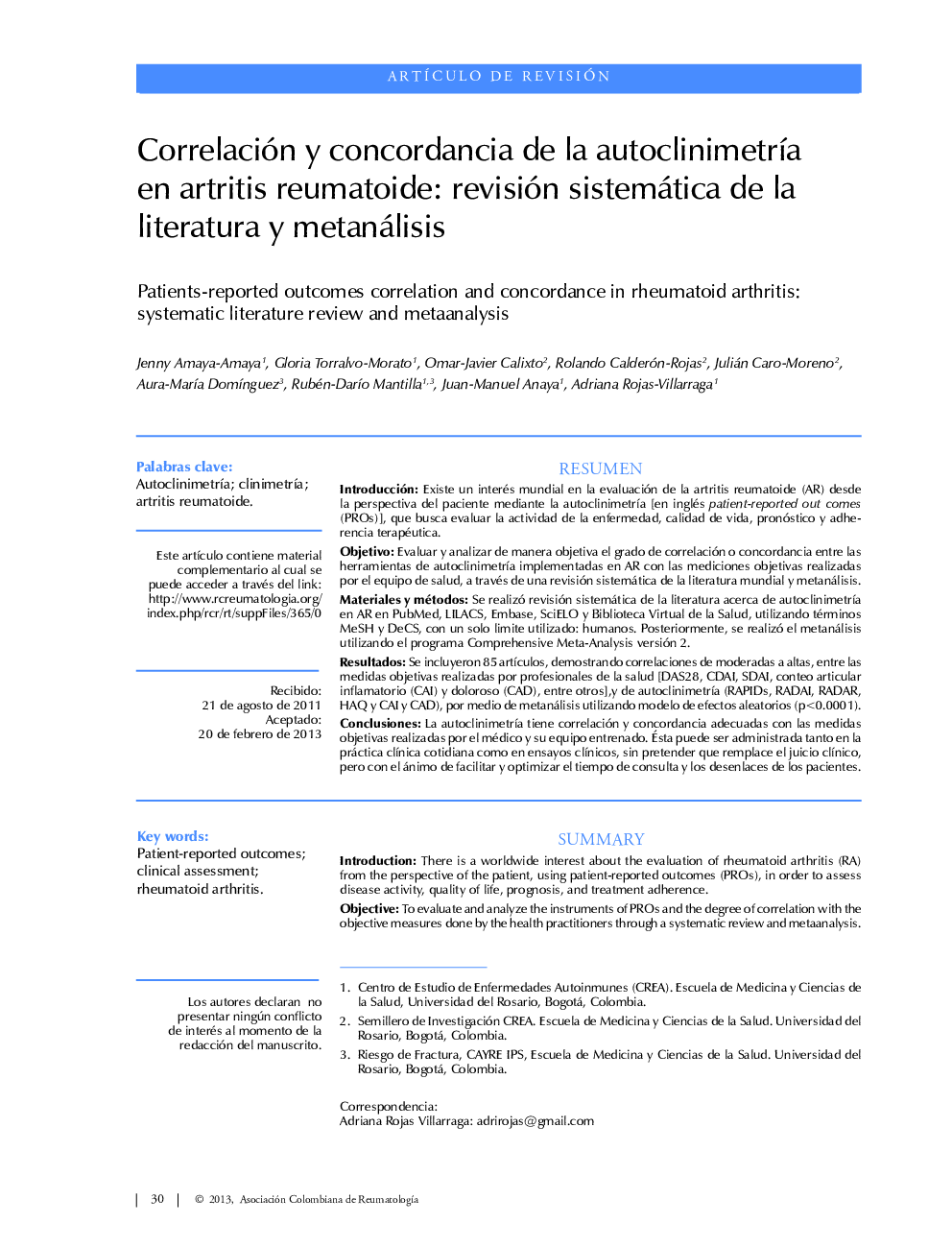| Article ID | Journal | Published Year | Pages | File Type |
|---|---|---|---|---|
| 3385505 | Revista Colombiana de Reumatología | 2013 | 28 Pages |
ResumenIntroducciónExiste un interés mundial en la evaluación de la artritis reumatoide (AR) desde la perspectiva del paciente mediante la autoclinimetría [en inglés patient-reported out comes (PROs)], que busca evaluar la actividad de la enfermedad, calidad de vida, pronóstico y adherencia terapéutica.ObjetivoEvaluar y analizar de manera objetiva el grado de correlación o concordancia entre las herramientas de autoclinimetría implementadas en AR con las mediciones objetivas realizadas por el equipo de salud, a través de una revisión sistemática de la literatura mundial y metanálisis.Materiales y métodosSe realizó revisión sistemática de la literatura acerca de autoclinimetría en AR en PubMed, LILACS, Embase, SciELO y Biblioteca Virtual de la Salud, utilizando términos MeSH y DeCS, con un solo limite utilizado: humanos. Posteriormente, se realizó el metanálisis utilizando el programa Comprehensive Meta-Analysis versión 2.ResultadosSe incluyeron 85 artículos, demostrando correlaciones de moderadas a altas, entre las medidas objetivas realizadas por profesionales de la salud [DAS28, CDAI, SDAI, conteo articular inflamatorio (CAI) y doloroso (CAD), entre otros],y de autoclinimetría (RAPIDs, RADAI, RADAR, HAQ y CAI y CAD), por medio de metanálisis utilizando modelo de efectos aleatorios (p < 0.0001).ConclusionesLa autoclinimetría tiene correlación y concordancia adecuadas con las medidas objetivas realizadas por el médico y su equipo entrenado. Ésta puede ser administrada tanto en la práctica clínica cotidiana como en ensayos clínicos, sin pretender que remplace el juicio clínico, pero con el ánimo de facilitar y optimizar el tiempo de consulta y los desenlaces de los pacientes.
SummaryIntroductionThere is a worldwide interest about the evaluation of rheumatoid arthritis (RA) from the perspective of the patient, using patient-reported outcomes (PROs), in order to assess disease activity, quality of life, prognosis, and treatment adherence.ObjectiveTo evaluate and analyze the instruments of PROs and the degree of correlation with the objective measures done by the health practitioners through a systematic review and metaanalysis.Materials and methodsA systematic review was done in PubMed, LILACS, Embase, SciELO y Virtual Library Health (Biblioteca Virtual de la Salud) databases, using the MeSH terms and DeCS, with limit: Humans. A metaanalysis was done using the software Comprehensive Meta-Analysis version 2.Results85 articles were included, finding high to moderate correlations between the objective measures performed by trained health care practitioners [DAS28, CDAI, SDAI, swollen joint count (SJC) and tender joint count (TJC) among others] and PROs (RAPIDs, RADAI, RADAR, HAQ, SJC and TJC) through metaanalysis applying the random effect models (p<0.0001).ConclusionsPROs have an adequate correlation and concordance with the objective measures done by the health care practitioners. It can be administrated in the clinical practice and clinical trials, without pretending to replace the clinical concept but with the aim to facilitate and optimize the clinical consult and the patient outcomes.
